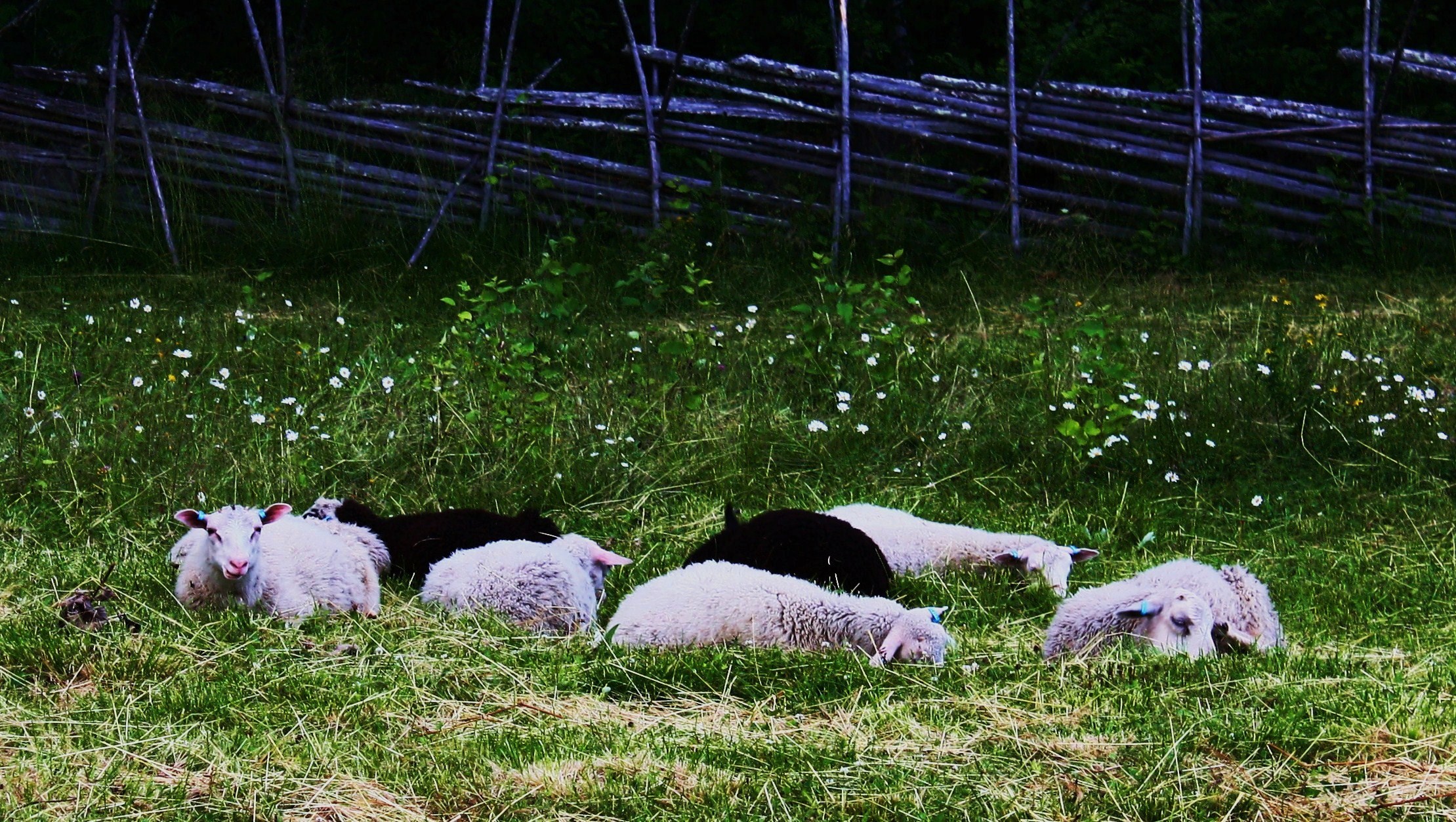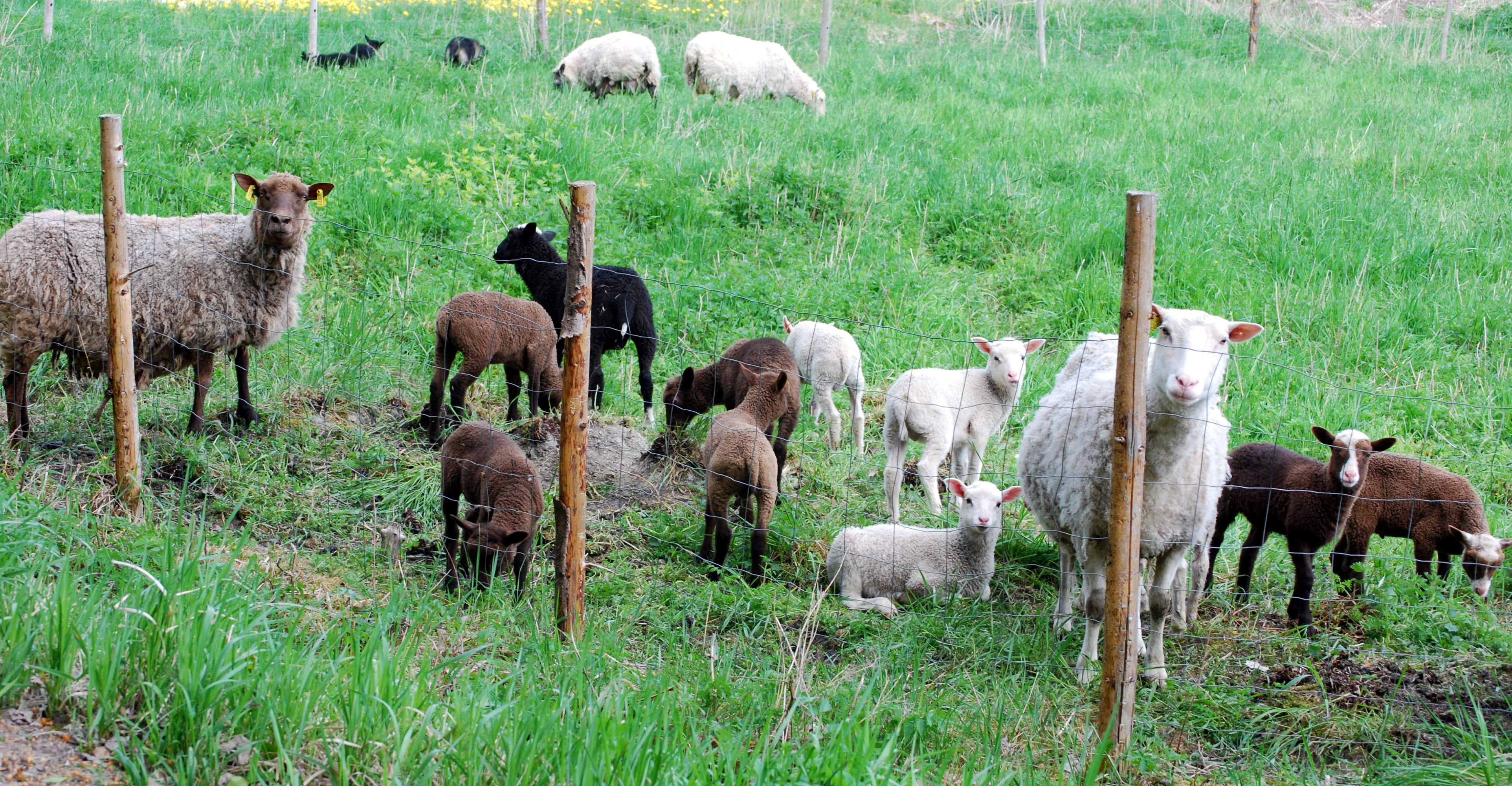Finnsheep ram close-up.jpg on:
[Wikipedia]
[Google]
[Amazon]
The Finnish Landrace, Finn or Finnsheep is a breed of

http://www.sheepusa.org
The wool has a soft handle, a moderate crimp and a high luster. Finnsheep have a similar range of fleece colors to that of Shetland and Icelandic sheep. White is genetically dominant and the most common color. Black and black piebald (spotted) sheep are also fairly common, while brown, grey and fawn Finnsheep are very scarce in the USA. Markings such as white stockings, tail tips, white crown or facial markings including the panda-like eyespot pattern, are common in colored Finnsheep.
Australian Finns are universally white; the wool has superior length, softness, better radius of curvature and reduced prickle factor. In Australia, wool quality and length have improved greatly to the extent that there are now sheep which can be shorn twice per year and whose advantageous wool characteristics have been extensively incorporated into the Merino flock.
Finnsheep have a similar range of fleece colors to that of Shetland and Icelandic sheep. White is genetically dominant and the most common color. Black and black piebald (spotted) sheep are also fairly common, while brown, grey and fawn Finnsheep are very scarce in the USA. Markings such as white stockings, tail tips, white crown or facial markings including the panda-like eyespot pattern, are common in colored Finnsheep.
Australian Finns are universally white; the wool has superior length, softness, better radius of curvature and reduced prickle factor. In Australia, wool quality and length have improved greatly to the extent that there are now sheep which can be shorn twice per year and whose advantageous wool characteristics have been extensively incorporated into the Merino flock.
 Finnsheep were first brought to North America by the
Finnsheep were first brought to North America by the
domestic sheep
Sheep or domestic sheep (''Ovis aries'') are domesticated, ruminant mammals typically kept as livestock. Although the term ''sheep'' can apply to other species in the genus '' Ovis'', in everyday usage it almost always refers to domesticated ...
native to Finland. It is one of several Northern European short-tailed sheep
The Northern European short-tailed sheep are a group of traditional sheep breeds or types found in Northern Europe, mainly in the British Isles, Scandinavia, Greenland and the area around the Baltic. They are thought to be derived from the fir ...
breeds, but is notable for its high incidence of multiple birth
A multiple birth is the culmination of one multiple pregnancy, wherein the mother gives birth to two or more babies. A term most applicable to vertebrate species, multiple births occur in most kinds of mammals, with varying frequencies. Such bir ...
s – it is common for a ewe to have three, four, or even five lamb
Lamb or The Lamb may refer to:
* A young sheep
* Lamb and mutton, the meat of sheep
Arts and media Film, television, and theatre
* ''The Lamb'' (1915 film), a silent film starring Douglas Fairbanks Sr. in his screen debut
* ''The Lamb'' (1918 ...
s at once.
The lambs are often small, but are vigorous at birth and grow well. The lambs mature early and can be mated at six months of age. Ewes commonly breed out of season and some may lamb twice in a year. The breed belongs to the group of Northern European short-tailed sheep
The Northern European short-tailed sheep are a group of traditional sheep breeds or types found in Northern Europe, mainly in the British Isles, Scandinavia, Greenland and the area around the Baltic. They are thought to be derived from the fir ...
, which also includes Shetland, Icelandic, Romanov
The House of Romanov (also transcribed Romanoff; rus, Романовы, Románovy, rɐˈmanəvɨ) was the reigning imperial house of Russia from 1613 to 1917. They achieved prominence after the Tsarina, Anastasia Romanova, was married to ...
, Spaelsau, and several other breeds.
The Finnsheep is often used in crossbreeding programs to increase lambing percentage, and Finnsheep blood is found in many of the newer breeds.
Characteristics
Wool
The fineness of Finnsheepwool
Wool is the textile fibre obtained from sheep and other mammals, especially goats, rabbits, and camelids. The term may also refer to inorganic materials, such as mineral wool and glass wool, that have properties similar to animal wool. ...
has some individual variation, but the American Sheep Industry’s Wool Council ranks Finnsheep in the fine end of the medium wool category.''Wool Grades and the Sheep that Grow the Wool'', from the American Wool Council, a division of the American Sheep Industry Association, 6911 South Yosemite Street, Englewood, CO 80112-1414 http://www.sheepusa.org
The wool has a soft handle, a moderate crimp and a high luster.
 Finnsheep have a similar range of fleece colors to that of Shetland and Icelandic sheep. White is genetically dominant and the most common color. Black and black piebald (spotted) sheep are also fairly common, while brown, grey and fawn Finnsheep are very scarce in the USA. Markings such as white stockings, tail tips, white crown or facial markings including the panda-like eyespot pattern, are common in colored Finnsheep.
Australian Finns are universally white; the wool has superior length, softness, better radius of curvature and reduced prickle factor. In Australia, wool quality and length have improved greatly to the extent that there are now sheep which can be shorn twice per year and whose advantageous wool characteristics have been extensively incorporated into the Merino flock.
Finnsheep have a similar range of fleece colors to that of Shetland and Icelandic sheep. White is genetically dominant and the most common color. Black and black piebald (spotted) sheep are also fairly common, while brown, grey and fawn Finnsheep are very scarce in the USA. Markings such as white stockings, tail tips, white crown or facial markings including the panda-like eyespot pattern, are common in colored Finnsheep.
Australian Finns are universally white; the wool has superior length, softness, better radius of curvature and reduced prickle factor. In Australia, wool quality and length have improved greatly to the extent that there are now sheep which can be shorn twice per year and whose advantageous wool characteristics have been extensively incorporated into the Merino flock.
Meat
Although not a large sheep, Finns produce a lean, succulent meat with a delicate and mild flavor, even as adults.Fertility
Finnsheep mature early and are known for their fertility. Rams can be bred at four to eight months of age, and ewes are expected to lamb at twelve months with multiple lambs. Although twins and triplets are most common, there have been litters born with as many as seven viable lambs.United States
 Finnsheep were first brought to North America by the
Finnsheep were first brought to North America by the University of Manitoba
The University of Manitoba (U of M, UManitoba, or UM) is a Canadian public research university in the province of Manitoba. By 1971, The Finnsheep Breeders Association had formed, providing shepherds with a standard of documentation to maintain and improve the integrity of the breed.
Currently, there are two recognized registries in the US for Finnsheep: the FBA (Finnsheep Breeders Association) and the IFR (International Finnsheep Registry).

International Finnsheep Registry
The US Finnsheep Breeders Association
Australian Finnsheep
{{commons category, Finnsheep Sheep breeds originating in Finland Sheep breeds

Australia
The breed was brought to Australia in two main importations: by the University of NSW in 1981 and by the Australian Texel Corporation in 1993. Considerable breeding efforts have since been undertaken to develop the strain to be better suited to the Australian climate. Lamb size and survival rates have increased. Typical litter sizes are three or four lambs. Further improving mothering, milk yield, and hardiness in paddock conditions, are the primary goals of the breeding program. The breed has been used extensively for crossbreeding to produce sheep with various desirable characteristics, but particularly leanness, better wool production and improved fertility and fecundity (more lambs) and excellent " doing" ability. An important feature of Finnsheep is their thin, wrinkle-free skin and bare breech. This means Finn-cross sheep are much less susceptible to flystrike thanMerino
The Merino is a breed or group of breeds of domestic sheep, characterised by very fine soft wool. It was established in Spain near the end of the Middle Ages, and was for several centuries kept as a strict Spanish monopoly; exports of the bree ...
s and do not require mulesing
Mulesing is the removal of strips of wool-bearing skin from around the breech (buttocks) of a sheep to prevent the parasitic infection flystrike (myiasis).
The wool around the buttocks can retain feces and urine, which attracts flies. The scar t ...
, a contentious operation intended to reduce the incidence of flystrike. Their skins produce more better-quality wool, as well as superior leather.
Australian Finns (and particularly Finn crosses) are extraordinarily lean and have contributed greatly to an improvement in the leanness of first- and second-cross lambs. They are also more resistant to intestinal parasites than many other breeds, and to a range of other problems such as pregnancy toxaemia ("twin lamb disease"), coccidiosis, and facial eczema.
The most common cross in Australia is the Finn-Merino. Many flocks have achieved lamb survival rates over 180% and twice a year shearing of high quality wool
Wool is the textile fibre obtained from sheep and other mammals, especially goats, rabbits, and camelids. The term may also refer to inorganic materials, such as mineral wool and glass wool, that have properties similar to animal wool. ...
from large flocks (1,000 + sheep per flock) of this cross. Other numerically important crosses include Finn-Dorset
A Finnish Dorset is a crossed-breed sheep, half Finnsheep, and half Dorset breed.
Dolly the sheep, first mammal to be cloned from an adult somatic cell
Cell most often refers to:
* Cell (biology), the functional basic unit of life
Cell may ...
s and Finn-Texels. The Finnsheep is having a significant effect on improving average productivity of Australian flocks.
References
External links
International Finnsheep Registry
The US Finnsheep Breeders Association
Australian Finnsheep
{{commons category, Finnsheep Sheep breeds originating in Finland Sheep breeds